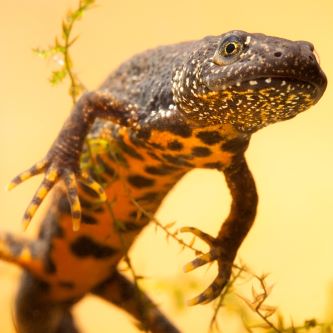
Planning for great crested newts
As a protected species, great crested newts are an important consideration in planning for wildlife.
Planning for great crested newts requires specialist skills and licences for surveys, assessment and mitigation.
Our knowledge of their ecology and their legal protections can help you :- create a successful design that benefits you and them
- demonstrate the sustainability of your development
- and deliver your project on time.
Where are great crested newts found ?
Great crested newts are generally common throughout lowland England and Wales [#1]. There are a few exceptions: there are no great crested newts for instance in Cornwall or south-west Wales. Certain areas of England seem to hold higher densities of newts, for example East Anglia, the Midlands and Cheshire. This is because their distribution is tied to landscapes rich in ponds.
During the spring and summer months, great crested newts live in aquatic habitats, particularly well-vegetated ponds with good water quality and without fish or high numbers of wildfowl. Newts favour ponds that dry periodically. Drying out removes fish and dragonfly larvae that feed on the newt’s tadpoles – the “efts”.
During other times, great crested newts use habitats such as woodland, scrub, hedgerows and tall grassland. They prefer moist conditions and often becoming inactive during periods of dry weather. In winter newts hibernate in places with high moisture and stable temperatures such as log piles and hedgebanks. Generally though newts do not stray far from their breeding ponds.
Brownfield sites and urban edges
Great crested newts can also be common on brownfield sites. Abandoned mineral pits form ideal breeding ponds and rough grassland and scrub ideal terrestrial habitat. Rubble and broken masonry are ideal places for hibernation.
Great crested newts can also be common on urban fringes where brownfield sites and mosaics of landuse such as horse paddocks, allotments and scrub are also commoner.
When is a great crested newt survey needed ?
Great crested newt surveys will often be requested when development might affect ponds or terrestrial habitat that newts might use. Data is collected on ponds that newts may be present in and on the extent and size of any population. From this, it is inferred what surrounding terrestrial habitat is important to the local population.
The knowledge of their populations allows an assessment on how newts might be affected and whether these impacts are avoidable. It also ensures a sustainable design that allows for newts, both for
- for negative impacts e.g. raised kerbstones, which lead them into gully traps and can cause high mortality; and
- for positive ones e.g. creating new connecting hedgerows and wetlands for them.
What does a great crested newt survey involve ?
Surveys generally start with a desktop appraisal to locate nearby ponds and find any existing records for the species. A day-time visit often follows to assess the quality of the ponds and the suitability of surrounding terrestrial habitat for newts.
Based on the likely impacts from a project, an ecologist can then make recommendations on what further surveys ( if any ) are needed to gather additional data.
Further surveys are generally nocturnal, using torches, nets and specialised traps. Searching for their distinctive eggs is also possible in daytime. The surveys find populations and estimate the population densities.
Testing for their DNA in pond water can also identify the presence ( or absence ) of great crested newts. This technique is termed environmental DNA sampling or eDNA[#2].
What time of year can ecologists carry out a great crested newt survey ?
An initial site appraisal can be carried out at any time or year. However walkovers are more informative in the spring and summer months.
Nocturnal surveys take place between mid-March and mid-June in suitable weather. For eDNA the survey period is longer: these tests can take place between early March and end of June.
Are newt surveys only possible between March and June ?
Whilst optimal surveys are only possible in a restricted window, sometimes:
- a site will have no nearby suitable ponds OR
- the works will not affect ponds due to the distances OR
- there are other more complex scenarios in place.
In these cases, ecologists may be able to gather sufficient evidence for an assessment of impacts at other times of year. Therefore delaying commencing surveys is not always necessary.
What happens if newts are found ?
If newts are found early, sometimes effects on newts can be avoided for example by :
- Exluding existing ponds and terrestrial habitat features from the site design; OR
- Timing of work e.g. carrying out works during the winter to avoid migrating newts; OR
- Altering methods e.g. avoiding temporary impacts by relocating routes of construction roads .
This may also allow effects on newts to be ruled out. Assessing whether there are effects and how they can be avoided requires careful consideration and specialist advice from an ecologist.
Where effects on great crested newts cannot be avoided then a package of mitigation will be needed to minimise long-term impacts and to prevent injury and exclude them from the site during the period of works. Compensation in the form of new ponds or habitat such as grassland and new hedgerows may also be required.
Once a package of mitigation has been agreed, then it needs assessing as to whether it can be delivered with or without a licence from Natural England.
Newt licencing and Natural England
Natural England issues great crested newt licences to developers allowing temporary impacts on the newts provided that there is no long-term effects on their populations.
The application requires a named ecologist, who is suitably qualified to supervise the work, and they will also assist you in preparing the application and supervising carrying it out. Natural England needs planning permission ( or other consents such as confirmation of Permitted Development Rights ) to have been granted before the application is accepted.
Natural England can take from upwards of 6 weeks to issue a licence, but once granted the licence can be used for a duration of several years.
Where the licence is required for public health or safety ( e.g. urgent repair works to a public water supply ), Natural England issues licences by an alternative quicker route.
When works are complete, ecologist will generally monitor the newts to see if the works have successfully avoided impacts on newts. This also allows a way to identify any problems and fix them by remedial action.
Further reading on great crested newts
Natural England (2015) Great crested newts: surveys and mitigation for development projects: Standing advice for local planning authorities who need to assess the impacts of development on great crested newts. [#3]
Langton, T.E.S., Beckett, C.L., and Foster, J.P. (2001), Great Crested Newt Conservation Handbook, Froglife, Halesworth [#4]
